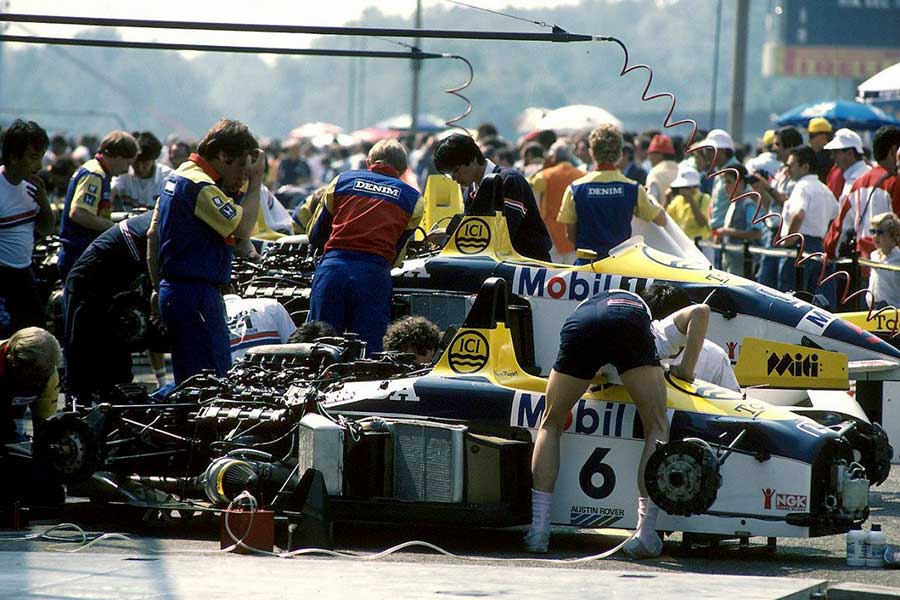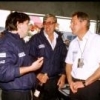I doubt it was kevlar - pretty nasty stuff to work with and yellow coloured so not suitable for use “naked” - much more likely to be carbon which is stiffer, easier to cut and drill, more durable and of course black. In fact these days there is a return to that idea of leaving the carbon surfaces uncovered for the black elements of livery. No point in putting black wrap onto black carbon, especially as one can achieve a decent finish out of the mould. As the saying goes, “they’ll never see it from the stands at 200 miles an hour”. As Kayemod can remind us, none of this is all that new - the gfrp panels made by Specialised Mouldings in the Sixties used a pigmented gel coat which didn’t need painting.
I've only just noticed Nigel's namecheck in his post, so in the hope that it will help others to understand a few mysteries, here's a little clarity on composite structures. All of these are essentially cured resin structures reinforced by strengthening fibres of various kinds, usually catalyst-cured polyester with glass strengthening in earlier times, the glass took the form of glass fibres, either in the form of random oriented mat or woven glass cloth, or a combination of the two. The name 'Fibreglass' is actually the Manufacturer's brand name, but it's the word most frequently used, much in the same way that almost all vacuum cleaners are referred to as 'Hoovers'. Things have moved on, and nowadays at higher levels of the sport, structures or mouldings are most often heat cured polyepoxide or epoxy resin, reinforced by impregnated carbon or Kevlar fibres. Each of these reinforcing mediums have their own advantages and disadvantages. Glass is by far the most user friendly, and many one-off and limited production mouldings have been produced by semi skilled enthusiasts in their garages, as Barry Boor for one could confirm. Carbon and Kevlar reinforcements are in a wholly different league, both require heat curing, this necessitates an oven or autoclave, which adds hugely to the cost. Also, those materials are expensive, far more than glass, with Kevlar usually somewhat cheaper than carbon fibre, but it brings problems that are all its own.
As Nigel says, Kevlar, also a registered brand name, is not the nicest stuff to work with. The dry woven material demands special cutting shears, normal ones are useless, and it's the same with drills etc for the cured mouldings. Advantages when used in race car monocoques or bodywork, is that the stuff possesses very good impact and abrasion resistance and it can save weight in comparison with equivalent glass or carbon structures. The main disadvantages are that exposed fibres absorb water, and mouldings have poor resistance to sunlight, UV light in particular, so paint or some other protective coating is essential. It's perhaps most often encountered as lightweight armour, stab and bulletproof clothing, and cut-proof gloves for butchers and the like. The only Kevlar reinforced epoxy bodywork I've had much experience with was made years ago for the Gulf Mirage GR7, and possibly the GR8 as well. The manufacturing process encountered numerous problems, and because of the susceptibility to UV damage, the cars had to be painted in their usual zenith blue/tangerine colours. The aim had been weight saving, but I doubt if there was any significant benefit overall, and the costs were huge.
Carbon is currently the most expensive type of fibre reinforcement, but it is the now most frequently encountered in motor sport generally, especially bodywork and monocoques. Sunlight and UV don't bother it much, and bare mouldings can look quite attractive in their own right. Some disadvantages are that metals in contact can corrode, but on a weight for weight basis, carbon has the highest compressive and tensile strength, is the most rigid, and has a low coefficient of thermal expansion. Unlike Kevlar, carbon is sometimes being used in road cars, both for lightweight body parts and interior and exterior embellishment, possibly partly as an excuse for the Manufacturer to charge more, but my last road car, an Alfa Giulia, had a carbon fibre reinforced prop shaft, so carbon is not just a pretty face.
Thread drift I suppose, a TNF speciality, but don't you just love it?
PS, Apologies for describing Barry Boor as "semi-skilled". He and the rest of his bunch should have got a Mention in Dispatches at the very least.
Edited by kayemod, 12 January 2022 - 23:09.


























